Wakening Lair
Author: Mike Richie
Publisher: Rather Dashing Games
Number of Players: 2-6 Players
Play Time: 30-40 Minutes
Price: $34.95
Copy Provided by Publisher
2018
Wakening Lair is something of a mystery and a miracle: it manages to take the genre of dungeon crawling and distills it down to its simplest parts. It’s a miracle because almost all of the games that I have that call themselves dungeon crawler are big, bulky things. They either have a lot of rules to account for, or enough miniatures to fill up a closet. Here, Wakening Lair fits all of this its modest little box.
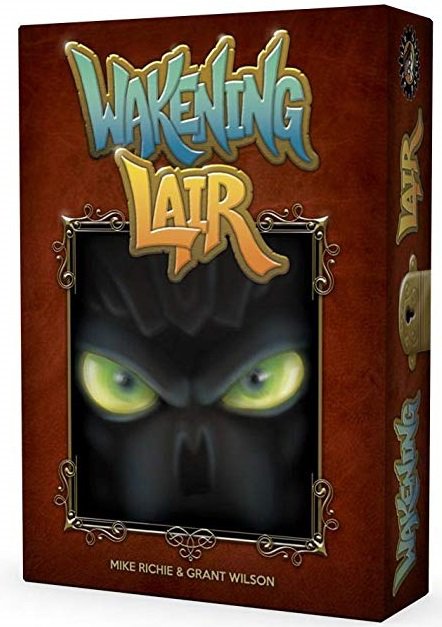
It opens on the side, like an angry mimic!
It’s a mystery because I didn’t think you could make a dungeon crawler this small and compact. I naturally thought that part of the fun of the experience was seeing the table littered with monsters, with heroes poised in dramatic poses. Wakening Lair has no miniatures, no fistfuls of dice. Instea, with some large cards, some wooden markers, and just three dice, this game promises to give you a full experience in less than an hour.
There’s really just one question left – does it work?
How To Race A Dungeon Boss
The premise of Wakening Lair – like so much else about this game – gets right to the point. There’s a giant monster that is waking up for the first time in years/months/millenia, and that monster wants to get out there to cause some good old-fashioned panic. As the plucky heroes, you’ve banded together to storm their lair to succeed. Of course, you don’t get there quite in time: the monster inevitably wakes up as you march down deeper to find it, and now it’s a race against time to defeat it before it escapes!
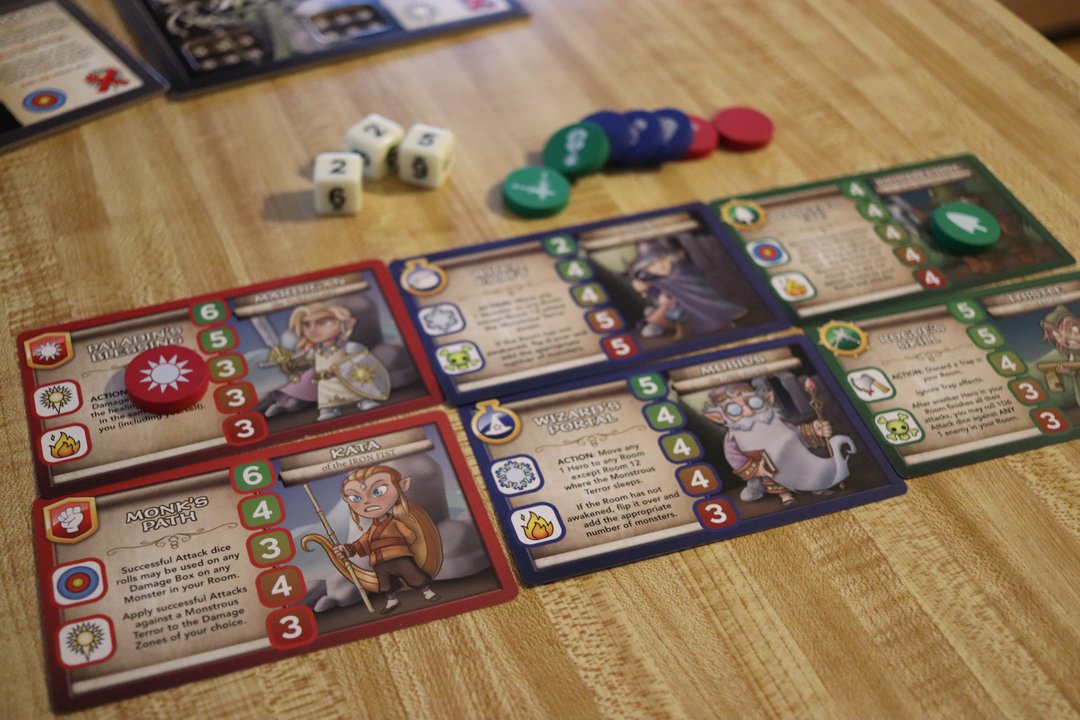
The heroes offer a lot of variety. Added bonus - each hero flips over to have alternate art! 9 male and 9 female heroes.
Set up is blissfully simple. Open the box, have everyone choose one of 9 heroes and take their matching marker. Shuffle the treasure, shuffle the monsters, and deal out the 12 dungeon floors in a face-down row. Take one of the (six!) final boss cards and place it facedown on the 12th floor. Shuffle in the ‘it wakes!’ card into the monster deck near the bottom, and you are ready to go.
The game runs turn by turn, where each hero has three actions to try and clear out the dungeon and work their way back towards the 12th room. However, at the start of each turn you roll 2d6: the number rolled ‘wakes up’ that room, flipping it over and populating it with one or two monsters. If the room is already awake, you just add another one. Moving into a room that hasn’t woken up also wakes it up, populating monsters.
This all sounds like a lot of trouble, but the reason you actually want monsters awake is because each time you kill one, they drop sweet, sweet, treasure that can help boost yourself (or a teammate) dramatically. You are going to need every bit of help you can get before the boss arrives, so rushing into fights from the start is an advantage.
The Right Hero For The Right Foe
This all begs the question: how does combat work in Wakening Lair? The answer is surprisingly deep for such a simple game.
Any hero can walk up to a monster on their floor and try to attack it by rolling a D6; beat the leftmost number on the monster card that hasn’t been given a damage cube, and you have wounded that monster. However, doing just this will not get you far very fast, and remember that you are on a timeline. Fortunately, each hero has two icons on their card that represent their specialties. The Paladin has access to light attacks, while the ranger has a ranged specialization, for example. This has multiple consequences that will determine if you can make luck work in your favor.
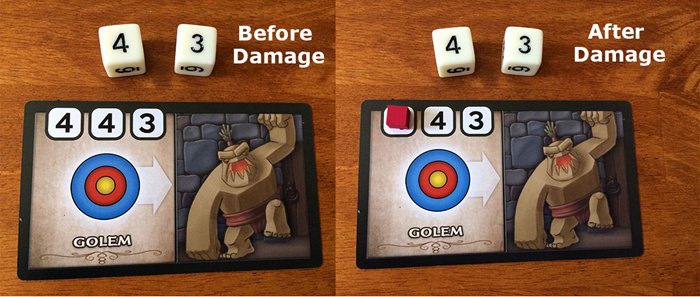
The first thing to remember is that having a hero in the same dungeon room as one of their specialties gets you a +1 to all die rolls. This is a huge way to increase your odds. The real benefit comes from matching up a hero to the type of monster. If your hero has a poison attack and the monster has a poison weakness, then every time you successfully hit them, you get to roll again for free. It’s called pressing the attack, and it’s the fastest way to make sure your turns are as effective as possible.
Getting items from defeating monsters can really speed up your assault. Valuable bracelets give additional actions, while weapons give heroes the chance to get new elemental type attacks. If you already have a specialty when you get a matching weapon, you now get to roll multiple D6 dice and choose the highest. Just remember that every monster you don’t kill in your room gets an attack back on you when your actions are used up. High risk means high reward, but it also can get you killed.
All of this so far has been the status quo of Wakening Lair, but that goes out the window as the main boss arrives.
The Big Bad Snowball
Once the boss arrives, Wakening Lair becomes an even more focused experience for your dungeoneering party; there are now only 12 turns left before the boss escapes the dungeon. If that happens, you lose. Great job everyone, you’ve unleashed an unholy terror into the world.
The only objective you have is to defeat the main boss, and once they have arrived, the good news is that no more small foes will appear. The bad news is that you cannot attack the main boss as long as any other foes are still left alive on the same floor as the boss. The worse news is that every time the boss moves up, it effectively shortens the dungeon, bringing every hero and monster with it.
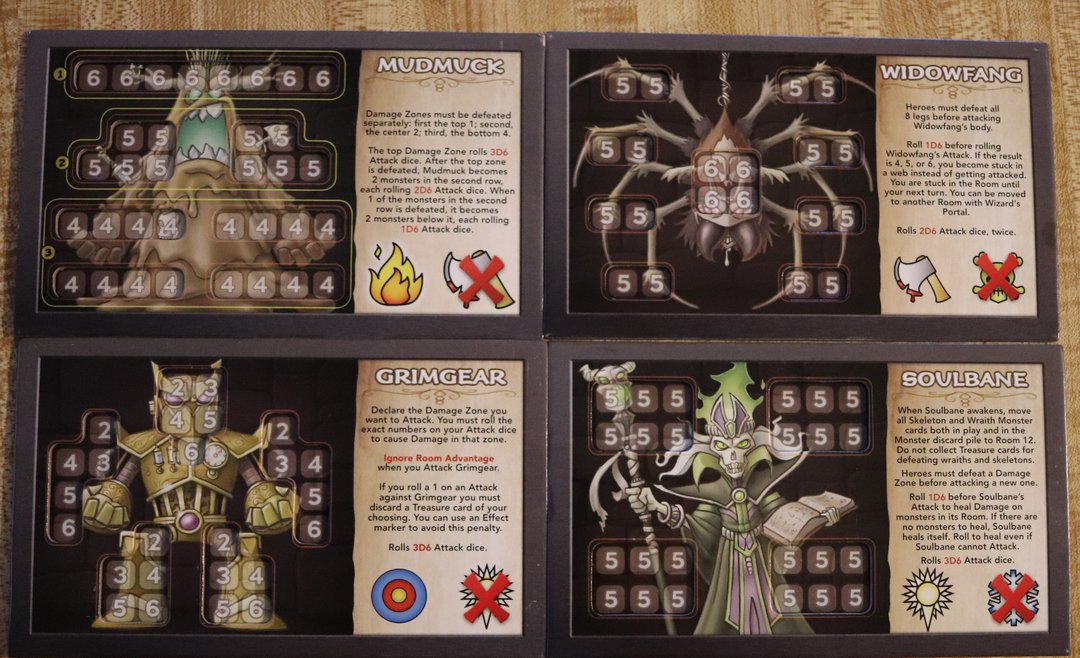
Each boss has its own theme and spin... but you don't know which you'll get until its time for it to wake up!
Remember when I said it’s important to try and clear the dungeon quickly? If you don’t, you end up with an avalanche of angry, seething bad guys protecting their leader while also beating the tar out of your team turn after turn. Having two or three monsters attacking you back in a turn can be very painful. Having six is a recipe for a dead hero.
It’s important to note that having just one dead hero spells game-over for your entire team. Fortunately, there are quite a few scrolls of resurrection in the treasure deck, which gives you yet another reason to kill as many small bad guys quickly so you have a backup plan before you get to this point.
One more thing: each boss has its own unique mechanic. The slime boss for example breaks into smaller components as you hack away at it. You have to fill up a line of boxes with 6+ high die rolls, but as you do, it splits into two weaker monsters. Sure, you now just need 5+ to hit, but it also gets to attack twice. On top of all of this, each boss has a different weakness and a different immunity. It’s another reason why this is a co-operative game, because you have to prepare multiple heroes to be real bad-asses when it’s time for the showdown.
So Much Going Right In A Tiny Box
If there is one thing going for Wakening Lair, it is intensity. It distills down the primary reasons you play a dungeon-crawling adventure into a package that gets right to the point with fun mechanics, tough moments, and fun.
This game is at its best when it throws you a few curveballs while still letting your team feel like it is gaining momentum. That moment when you pick up the right weapon, letting your barbarian now roll three dice with every attack? Beautiful! When you realize your wizard is able to teleport the rest of your team to the right rooms to fight with the right advantages? Perfect.
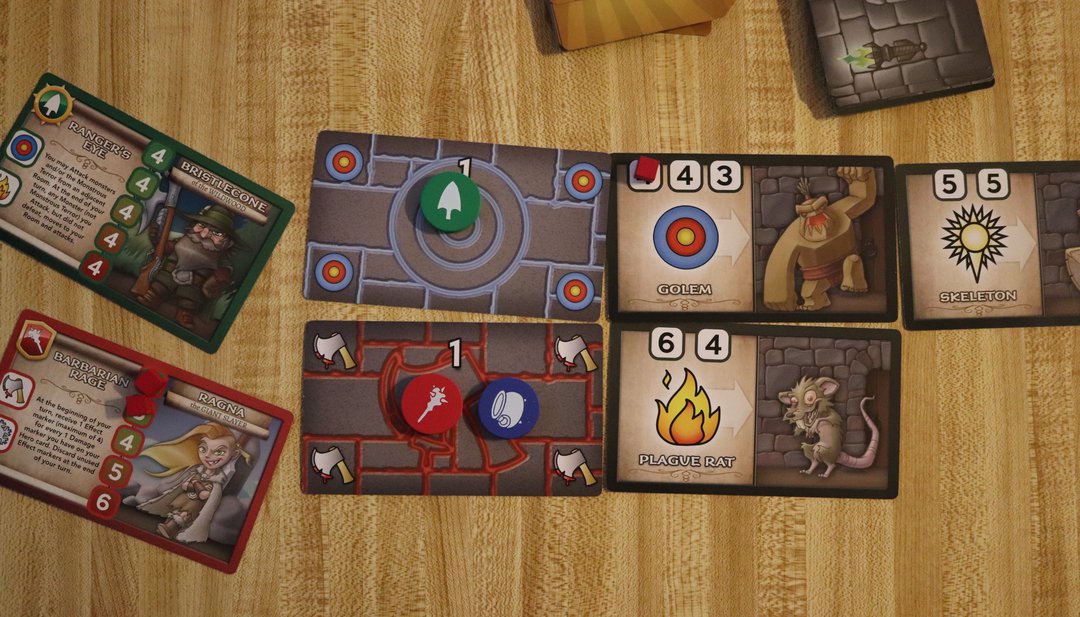
My favorite moment is still when the final boss arrives. When the big character sheet for the boss – which can be one of six different options – gets flipped over, and the team now knows that there are only 12 turns left in the game... well, you can see it on their faces. How everyone tries to start calculating if the game is winnable. What the best course of action is. Are there too many small bad guys on the board? Who should rush the boss, and who should clear the dungeon?
I’ve won or lost a lot of Wakening Lair games in the last 6 turns, when our desperate attempts to fight the wyvern/golem/lich turn into glorious triumph, or we are batted aside like so much garbage because we just couldn’t get our act together fast enough. The fact that I can get the experience above with up to 5 other people in less than an hour? Glorious.
The Problems Of Speed Dungeon Running
For all of the praise I’m giving out, I can’t say Wakening Lair is a perfect game. It accomplishes all that it sets out to do, but I know that its particular style will not be to everyone’s liking. The first ‘downside’ is that this is a game that relies heavily on dice for most of what you do. While you can mitigate it through acquiring weapons, coordinating support heroes, and attacking in the right rooms, it can sometimes feel like a particular game is destined to failure.
This is compounded by the fact that the game runs off of luck and randomization. Sometimes, the treasure deck is not your friend. I had one game where I was able to draw three scrolls of resurrection early in the game; while we appreciated the gesture, it also denied us much needed weapons to speed up our ability to clear the dungeon. Soon enough, the boss was out, and we just didn’t have what we needed to defeat the gang of 7+ monsters that it was travelling with.
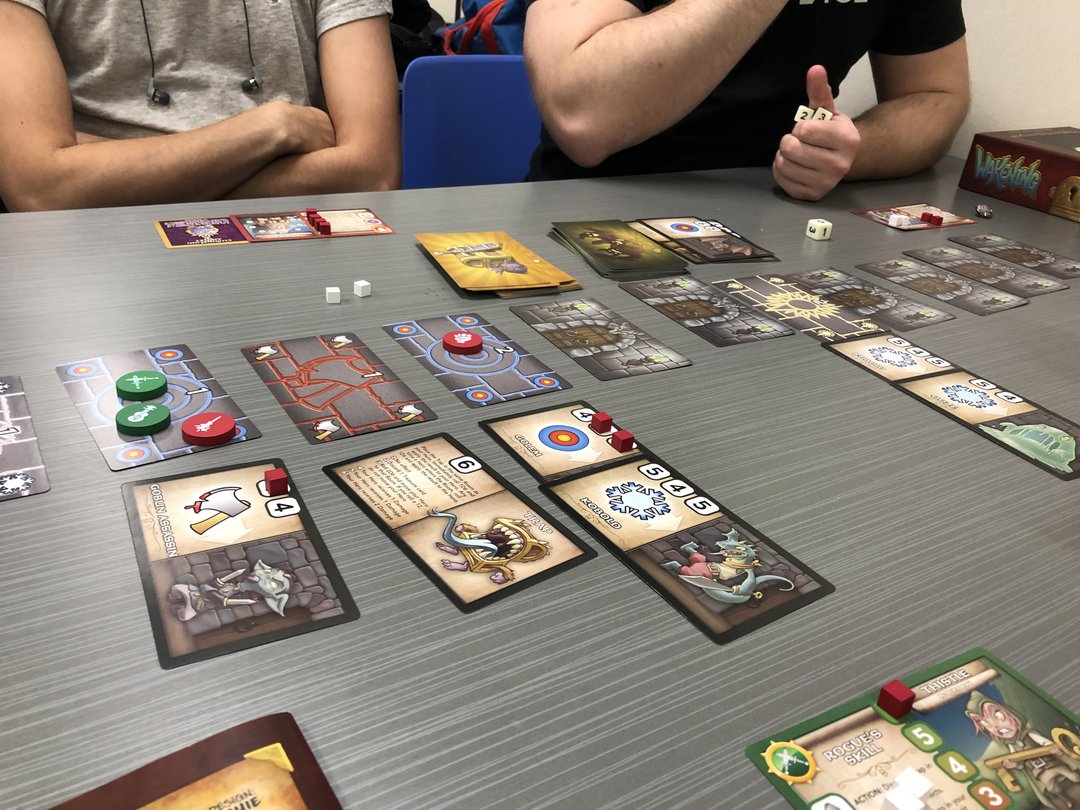
Hacking your way to victory is an absolute blast, just be aware some games might be doomed just because the dice hate you.
There’s some smaller issues, such as some heroes possibly having a little more power than others, but the main issue with Wakening Lair is that you should make sure you are okay with a game that runs more on luck than consistency. It’s a short game which always helps, but it still might not be a game for everyone.
Wakening Lair Is Proof That Great Genres Can Be Done Quick
Despite the setbacks I just talked about, Wakening Lair is a beautiful little package. I love the box and packaging it comes in, I love how easy it is to set up, break down, and explain. I enjoy that it lets me play with a lot of friends at once, and I enjoy how the heroes come in such a variety of types.
There is a lot going on here that should be praised. Since getting this game at PAX Unplugged, I haven’t taken it out of my board game bag for our meet-ups, and over fifteen people have played it with happy results. For only 35 dollars, this is a perfect purchase to add a game that is both short and sweet to your collection.